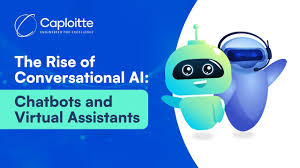
Just a few years ago, chatbots were clunky and frustrating—capable of answering only basic questions like “What’s your store’s return policy?” or “What time do you close?” Fast forward to 2025, and they’ve evolved into smart, seamless digital companions that can do everything from scheduling your week to diagnosing a health issue.
Whether it’s a chatbot helping you book a flight, or a voice assistant organizing your smart home, virtual assistants have quietly become embedded in daily life. And as artificial intelligence grows more powerful, their role is expanding—fast.
So how did we get here? And what does the rise of chatbots and virtual assistants mean for the way we live, work, and connect?
Let’s take a closer look at one of the fastest-moving revolutions in digital interaction.
1. From Scripts to Smart Conversations
Early chatbots operated on scripts. They recognized keywords, followed fixed paths, and broke the moment you asked anything unexpected. But in 2025, things are very different.
Thanks to breakthroughs in natural language processing (NLP), machine learning, and generative AI, today’s bots can:
- Understand context and tone
- Learn from past interactions
- Ask follow-up questions
- Handle multiple languages
- Even respond with emotion or humor
These upgrades have made virtual assistants feel less like tools—and more like digital coworkers or companions.
2. Everywhere, All the Time
Chatbots and virtual assistants are no longer limited to websites or smart speakers. They’ve become ubiquitous, operating across devices and platforms:
- On your phone (Siri, Google Assistant, Alexa)
- In your home (smart thermostats, fridges, lights)
- In cars (voice navigation, entertainment control)
- In workplaces (AI scheduling bots, HR assistants)
- On websites and apps (customer support, shopping guides, mental health tools)
In 2025, AI assistants are often the first—and sometimes only—point of contact between people and services. They answer questions, guide decisions, and even handle sensitive tasks like banking or medical consultations.
3. Personal Assistants for Everyone
One of the most exciting shifts in 2025 is the rise of personalized AI assistants that adapt to your habits, preferences, and routines.
Imagine:
- A chatbot that remembers your favorite coffee order and automatically schedules it on your commute
- A voice assistant that suggests a movie you’d love based on your mood and past choices
- An AI that helps you write emails, organize your calendar, and remind you to take breaks
These assistants are becoming more human-like—not just in language, but in behavior. They learn from your interactions, evolve with your lifestyle, and even anticipate your needs before you voice them.
4. Revolutionizing Customer Service
Businesses across every industry are embracing chatbots to improve customer service, reduce wait times, and cut costs.
Key benefits include:
- 24/7 availability
- Instant responses to common questions
- Multilingual support
- Ability to handle thousands of users at once
In sectors like e-commerce, banking, healthcare, and travel, chatbots are often more efficient than humans for front-line queries. Some even handle complex workflows like insurance claims or appointment bookings—without ever involving a person.
Still, the best systems often combine AI with a human touch—escalating issues to human agents when needed.
5. Voice Assistants as the New User Interface
Typing is slowly becoming optional.
Voice assistants are turning spoken language into a new form of interface, replacing taps and swipes with commands and conversations. Smart homes, cars, and devices are all adopting voice control as a standard feature.
In 2025, you can:
- Dim the lights, set the temperature, and play music just by speaking
- Dictate emails or texts while driving
- Ask for recipes, translations, or real-time updates without touching a screen
This hands-free convenience is especially game-changing for people with disabilities or limited mobility—making tech more accessible than ever before.
6. Chatbots in Education, Healthcare, and Beyond
Beyond customer service, chatbots and assistants are making waves in public services and personal development.
- In education: AI tutors help students study, quiz themselves, and get personalized feedback
- In healthcare: Symptom checkers, medication reminders, and mental health bots are supporting patients between doctor visits
- In HR and recruitment: Chatbots handle screening, onboarding, and even interview scheduling
- In finance: Virtual assistants help track spending, set budgets, and offer investment advice
These tools don’t replace professionals—but they enhance access, improve efficiency, and empower users with more control over their daily needs.
7. The Downsides: Privacy, Trust, and Dependence
As helpful as they are, virtual assistants also raise serious concerns.
- Privacy: How much do these bots know about you—and who else sees that data?
- Security: Could a hacked assistant access your bank info, medical records, or home devices?
- Bias and misinformation: AI responses can reflect harmful stereotypes or give incorrect information.
- Over-reliance: As assistants become more capable, will we lose certain skills—or critical thinking?
In 2025, many users are demanding more transparency, control, and accountability from companies building these bots. The race to make chatbots smarter must also be balanced with ethical, responsible design.
Final Thoughts
The rise of chatbots and virtual assistants in 2025 marks a turning point in how we interact with technology. No longer passive tools, these AI companions are becoming active participants in our digital lives—helping us stay informed, organized, productive, and even entertained.
